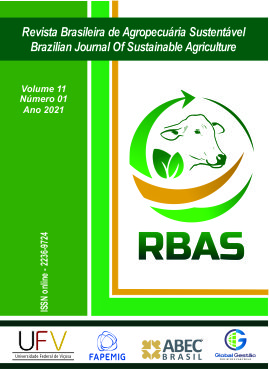MANEJO DA ADUBAÇÃO NITROGENADA E DA INOCULAÇÃO COM Azospirillum brasilense NO RENDIMENTO DE SILAGEM DO CONSÓRCIO MILHO-SOJA
Adubação no consórcio milho e soja
DOI:
https://doi.org/10.21206/rbas.v11i1.10383Keywords:
Glycine max, integrated systems, Zea mays.Abstract
Corn-soybean intercrop can increase silage yield, but it depends on nitrogen (N) supply to intercropped crops. This research evaluated the corn-soybean intercrop for silage production, as a function of inoculation with Azospirillum brasilense and nitrogen fertilization management. The inoculation of corn seeds with A. brasilense associated or not with fertilization of N at sowing and topdressing was tested. N supply by inoculation and/or fertilization did not change chlorophyll leaf index and macronutrient and micronutrient leaf contents in corn and soybean plants, except for copper. Intercropped soybean plants have become estiolate, with smaller plant population and lower dry mass compared to sole crop. The dry masses of the morphological components of the intercropped maize plants were similar to that of the sole crop, except for the leaves in the inoculated treatments and cover fertilization until V4, which were lower. Thus, the lowest silage yields were from soybean sole crop and intercropping with inoculated and fertilized maize plants with 30 kg ha-1 of N applied in V4. Inoculation of maize associated with N split in topdressing at doses higher than 30 kg ha-1 provided silage yield in the intercropping similar to that of corn sole crop. Thus, according to the area equivalence index, regardless of the treatments, the consortium showed no benefits regarding the total silage yield.
Downloads
Downloads
Published
How to Cite
Issue
Section
License
Copyright (c) 2021 Brazilian Journal of Sustainable Agriculture

This work is licensed under a Creative Commons Attribution-NonCommercial-NoDerivatives 4.0 International License.
1. Proposta de Política para Periódicos de Acesso Livre
Autores que publicam nesta revista concordam com os seguintes termos:
Autores mantém os direitos autorais e concedem à revista o direito de primeira publicação, com o trabalho simultaneamente licenciado sob a Licença Creative Commons Attribution que permite o compartilhamento do trabalho com reconhecimento da autoria e publicação inicial nesta revista.











